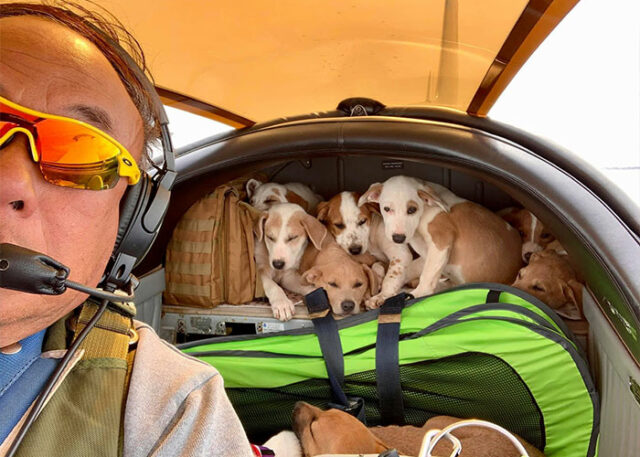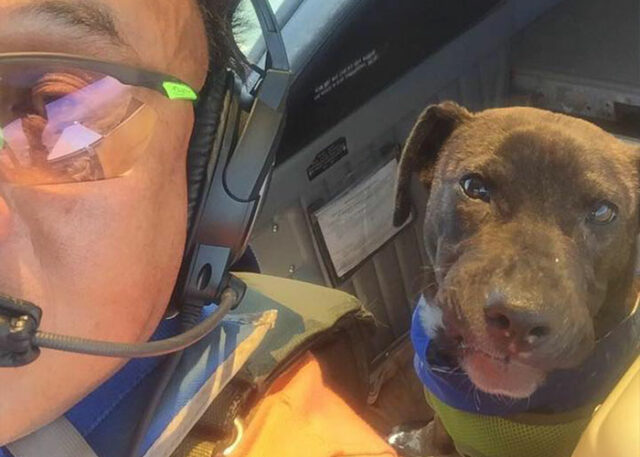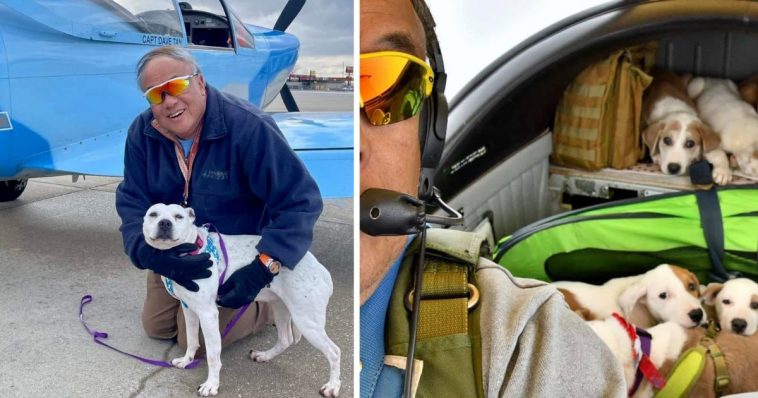David Tan of Middleton, Wisconsin, is our captain for today, and I’d want to introduce him to you all. He worked as a military, commercial, and private pilot for 40 years before retiring.
Even so, he continues to fly his two-seat Italian Aermacchi SF-260, which is often used for aerobatics and by lesser air forces. Who sits beside him on the second seat? Obviously a doggie in rescue!

He has flown more than 360 dogs since 2012. He is moving a mother and her eight pups to a secure location, as can be seen in this picture.
In addition, he traveled in the cockpit with 23 cats, three goats with frostbite, a potbelly pig, and even a bat that he assisted in transporting to an Ohio wildlife sanctuary.

“Naturally, we named [the bat] Bruce,” David said, explaining the hilarious connection to Batman’s identity, Bruce Wayne.
We got in touch with David to learn more about his life’s journey. “When I was in high school my parents bought me flying lessons and I got my private pilot license when I was 18,” he explained.
“I wasn’t good at anything else but managed to do reasonably in flying planes. It was a good career because I enjoyed what I was doing.”

It was truly an embodiment of the saying, ‘find a job you love and never work another day in your life,’ however, it wasn’t all smooth sailing. Or should I say, smooth flying? I’ll stop.
“I hated the failures and errors along the way,” David said, but “ultimately, I never had an accident and never injured anyone at the controls of a plane, so there are thousands of people who are worse than I am at piloting.”

The most important thing to remember in order to be a good pilot is to always try and make the best decisions. “We have a saying that ‘a superior pilot uses his superior judgment to avoid situations that would require the use of his superior skill,’” David explained.
“Decision areas include suitable weather, making sure the aircraft is in a good condition with the right amount of fuel to do the mission and loaded within limits. Flying is not particularly difficult, but a fool can make it difficult and dangerous through carelessness, recklessness, and stupidity.”

During his previous 15-year career as a rescue helicopter pilot with the Republic of Singapore Air Force, he had trained on the same aircraft.
Naturally, it bears his name, and the plane appears to be named Gina. The smoked brown upper panel of the bluebird flashes yellow in the cockpit when the sun shines on it.

After reading an article in an aviation trade publication, David learned about Pilots N Paws, a non-profit 501(c)(3) group with the straightforward mission of saving the lives of defenseless animals.
They bring together volunteer pilots and aircraft owners eager to help transport animals, plan or schedule rescue flights, provide overnight foster care or shelter, etc.

Typically, a rescue mission involves many pilots flying a distance of about 250 miles before passing the animal to another aircraft.
Most of David’s rescue missions occur in the southern states. “There are just some terrible stories out there [about] how cruel people can be to animals, especially down south; the abandonments are horrible,” David told Madison Magazine. “A family would just leave them, discard them like a piece of old furniture or something.”

One of the tales he told was April, a puppy whose owners had abandoned her after discovering she had urinated inside the home and taken her to the clinic to be put to death.
The vet instead contacted a rescue group, which led to David taking her and bringing her to a rescue in Iowa. “So that kind of gets me. I feel good when at least… I can contribute toward where they go,” he explained.

The pilot also works one-on-one with rescue organizations that he has come to know via his profession of transporting puppies around the nation. Fetch Wisconsin, Albert’s Dog Lounge, and Underdog Pet Rescue and Veterinary Services are some of the groups.
The Bissell Pet Foundation and the Dane County Humane Society have periodically collaborated to organize larger flights that carry more than 100 animals at once.

“It’s just amazing, the guys and gals who do this,” David said. “I’ve met them at the Dane County Airport before and there were like 10 different animals that came within a few hours. They just magically arrived, as far as we were concerned. These people are just really kind-hearted.”
Although most of the missions are purely transportation – taking the animal from one airport to the other – he does get those few lucky pups that are traveling to meet their new forever families. “You sort of say, ‘Hope you have a great rest of your life,’ you know?” David said. “‘Hope these people love you forever.’”

One of those lucky puppers was Buddy. According to a Facebook post by the Humane Society of Marathon County, the dog spent 142 days awaiting his new family, for “someone to see him.”
“To see beyond his age and his graying face. To see beyond his medical issues and bad in-kennel behavior. To see beyond his dislike of other pets and the stress of shelter life.”

It was love at first sight for Kelly, a visitor from California who had planned to adopt a senior dog from a homeless shelter, until she first spotted Buddy. She took him in despite his age and issues.
They were flying to sunny San Diego, California, and Buddy was dog 303 who entered the aircraft. She made it happen because she wanted to support us in giving him the life he deserved. Buddy, you are so loved and very proud of us! “, the society stated.

At times the families feel so grateful for his help that they try to pay him, but David never keeps the money, either giving it to the rescues or paying for medical costs associated with the animals they save.
“They’re always short [on money], especially when it comes to medical care for the animals,” David said. “It just costs so much nowadays.” He also brushes off any praise, saying: “The people who really pull the weight are the rescues.”

Considering the complex set of particular skills that flying requires, it requires continuous practice, requiring pilots to spend a lot of time flying, so as to not get rusty.
“If you fly, it’s a perishable skill and you must keep current,” David believes. “So rather than take a flight and go somewhere for what we call the proverbial $200 hamburger, I’d rather be flying dogs.”

Sadly, he doesn’t get to spend too much time with the animals, however, “Genevieve, a setter, and Frankie a German shepherd have been favorites,” both of which have found loving homes.
“I will fly my own plane as long as health and finances allow!” David said.

When asked what his one message would be to all of you, dear readers, he said: “Be kind to animals!”
“The reason I contribute my time and finances is that there is so much cruelty out there towards animals. I can’t change any of that, but can help the lucky ones in a small way.”
David continuously posts his adventures on his Facebook page, so if you’d like to learn more or see more adorable animals that he’ll rescue, make sure to check it out. Also, you can donate to Pilots N Paws via the link here, if you’d like to support their initiative.
We wish David all the best in his adventures and that many more pups get to experience the joys of taking flight.

